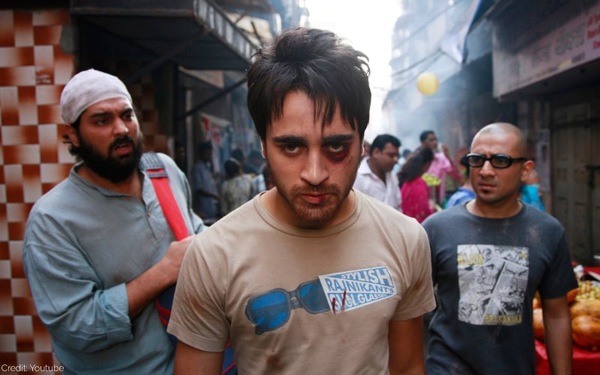10 Years Of Delhi Belly, The Film That Wants To Shock Us, Provoke Us

- Harsh B.H.
Film Companion
Last Updated: 02.30 PM, Jul 04, 2021

2011 was the year when mainstream Hindi cinema was still looking for a new definition of ‘cool’, well into a decade post Dil Chahata Hai. It was also right in the middle of a mini Anurag Kashyap wave (yes, there was a wave), where a space for more raw, real narratives was gradually being carved. There were a couple of contenders besides Kashyap – Vishal Bharadwaj, Dibakar Banerjee, Imtiaz Ali – all bringing in fresh sensibilities of their own to the mainstream template, creating some interesting work, but there was no new formidable language in place. In that chaos, the Abhinay Deo-directed (and Aamir Khan-produced) Delhi Belly was released.
There was a surge of noir comic capers around that time (Shor in the city, Kaminey, 99, Yeh Saali Zindagi, Sankat City), and Delhi Belly fell right in that zone. Its influence might not be earth-shattering, but it did help break the shackles some of our mainstream cinema was still struggling with. With a narrative inspired by the Quentin Tarantino/Guy Ritchie universe, Delhi Belly has all the noir-caper boxes firmly ticked.
Writer Akshat Verma showed a great flair for colour when it came to creating the universe and its characters. Delhi Belly is a truly American film in that sense. Thankfully, it also stays true to the spirit and sensibilities of the genre it clearly loves so much and doesn’t make any overt efforts to ‘Indianise’ the plot or proceedings – and yet, somehow, it finds itself comfortably at home in Delhi, a city where the have-nots and the privileged perfectly co-exist next to each other, without their wires ever being crossed, except for in crazy, chaotic narratives like this one.
The Tarantino influences are very apparent. Verma displays a great penchant for what I call the ‘counter-visuals,’ where he blends the casual and the cruel in the same frame, leaving us bemused at the collages. (At one point, a small-time goon grudgingly bemoans the stain on his new shirt, while a man wails and begs for his life in the background.) There is also abundant space made for non-sequitur dialogue amidst moments of crisis. Additionally, the way Deo builds some of the moments has a distinct Tarantino-esque feel to it.
The film is hyper-kinetic in its energy, brimming with caricatures and flavour – be it in the moody soundtrack, the exaggerated supporting characters (one of whom eats a banana with a fork and a knife), or the language they speak. The narrative operates at a breakneck speed, with all the actions running into each other a little too impatiently.
This is why the most beautiful screenwriting stroke eventually proves to be the opening credits set against the trippy ‘Saigal Blues’. Through a slow-burning set of still visuals – a bunch of restaurant menus thumbtacked on a board, pizza leftovers raided by a cockroach, a tap running furiously onto the floor with a careless bucket sitting right next to it, a cracked ceiling that could collapse any moment – the montage tells us everything we need to know about the characters we are going to follow and root for. The film overall displays abundant love for stylised visuals and finds plenty of humour in them (besides the crackling dialogue by Verma).
But obviously, Delhi Belly’s biggest victories lie in its demolition of the idea of a sacrosanct and sanitised universe that had always been held dear by the mainstream filmmakers. It’s almost like the film wants to make us look at everything a Hindi film viewer would turn his nose up at, say, ten or fifteen years ago. It loves provoking us, shocking us.
But it does it all merely by staying true to its universe, by being casual about it. Like a great stand-up act, Delhi Belly takes the power away from sex and profanity by placing them casually in the narrative, and yet gets laughs from them that don’t feel cheap. (This was probably the first film to visualise a scene of oral pleasure, without any intention to undercut it with humour. Not to mention the visual of Kunaal Roy Kapoor casually honking the breast of a prostitute continues to feature in my movie memories even now.)
And then, of course, there is the language: the hybrid, cuss-word-brimming language spoken by everyone, be it our righteous hero-figure or the calm-yet-sinister antagonist (Vijay Razz in a career-best performance). But more importantly, the colourful dialogue doesn’t feel performative or played for effect. It rings true, precisely because it appears casually in out of languages – just like real people speak. Not that Delhi Belly is the first film to incorporate cuss words to such an extent, but most of the successful precedents (Omkara, Gulaal) were set in relatively rural heartlands. Delhi Belly’s urbanity and profanity created a unique flavour of their own.
The film saves all the provocateur antics for its most memorable component – the scatological humour. It first displays great audacity by crafting the plot around the irregular bowel movements of a giant, goofy man-child. These scenes are obviously played for laughs – by juxtaposing toilet visits with the tensest of violent moments in the vicinity – but it still remains a shockingly unique idea, executed deftly.
And like any self-respecting noir-caper, Delhi Belly also has its homages, nods and meta-moments in place. The film begins with one of the coolest R.D. Burman compositions of yore, set to a pair of footsteps neatly falling in rhythm. One of the protagonists refers to Jackie Brown while worrying about whether a bagful of money is true to its name. And above all, Delhi Belly sets up a whole fictional movie as a part of its colourful backdrop, Return of Disco Fighter, which is clearly an amalgam of several popular Bollywood tropes from the ’70s and the ’80s. In another marvellously staged daydream, a bespectacled underdog avenges his cheating girlfriend dressed like the hero from his favourite film franchise as he dances at her shaadi. (The prelude to this, which comprises of the bride-to-be humiliated and slapped around in slow-motion, in a scene straight out of a soap opera.)
Imran Khan hasn’t been one of my favourite actors of the last two decades, but he is a perfect casting choice here – with his deadpan responses to a world clearly too self-obsessed and alien for his taste. Khan plays Tashi, a righteous, sincere prude who, as another character puts it, needs to loosen up. However, it’s Tashi’s overt righteousness that puts most of the events in a comical context, gaining all the more colour. And yet, it wouldn’t be accurate to call Tashi the protagonist, for Delhi Belly is loaded with characters who are all protagonists of their own stories. Vir Das plays Aroop, a mild-mannered animator who is dramatic enough to shave his head in a surge of self-destruction after being dumped by his girlfriend. And then, of course, we have Tashi’s second flatmate Nitin (Kunaal Roy Kapur), who likes to play god, often acting too clever for his own good, and yet fails to exercise any control over his literal shit.
And despite all the grey-shaded humanity around, Delhi Belly also has the heart of a feel-good parable by the end of it all. Nitin eventually decides to put a stop to his plans of blackmailing his good-natured landlord, Tashi willingly breaks up with Sonia (Shenaz Treasury) without knowing whether he has any future with his colleague-turned-lover Menaka (Poorna Jagannathan), and Aroop makes peace with orange juice. I mean, if Aroop could drink OJ again after what he had witnessed Nitin using it for (if you have seen the film, you know what I am talking about) – what reasons do we have to not give ourselves a second chance?
The post 10 Years Of Delhi Belly, The Film That Wants To Shock Us, Provokes Us appeared first on Film Companion.
